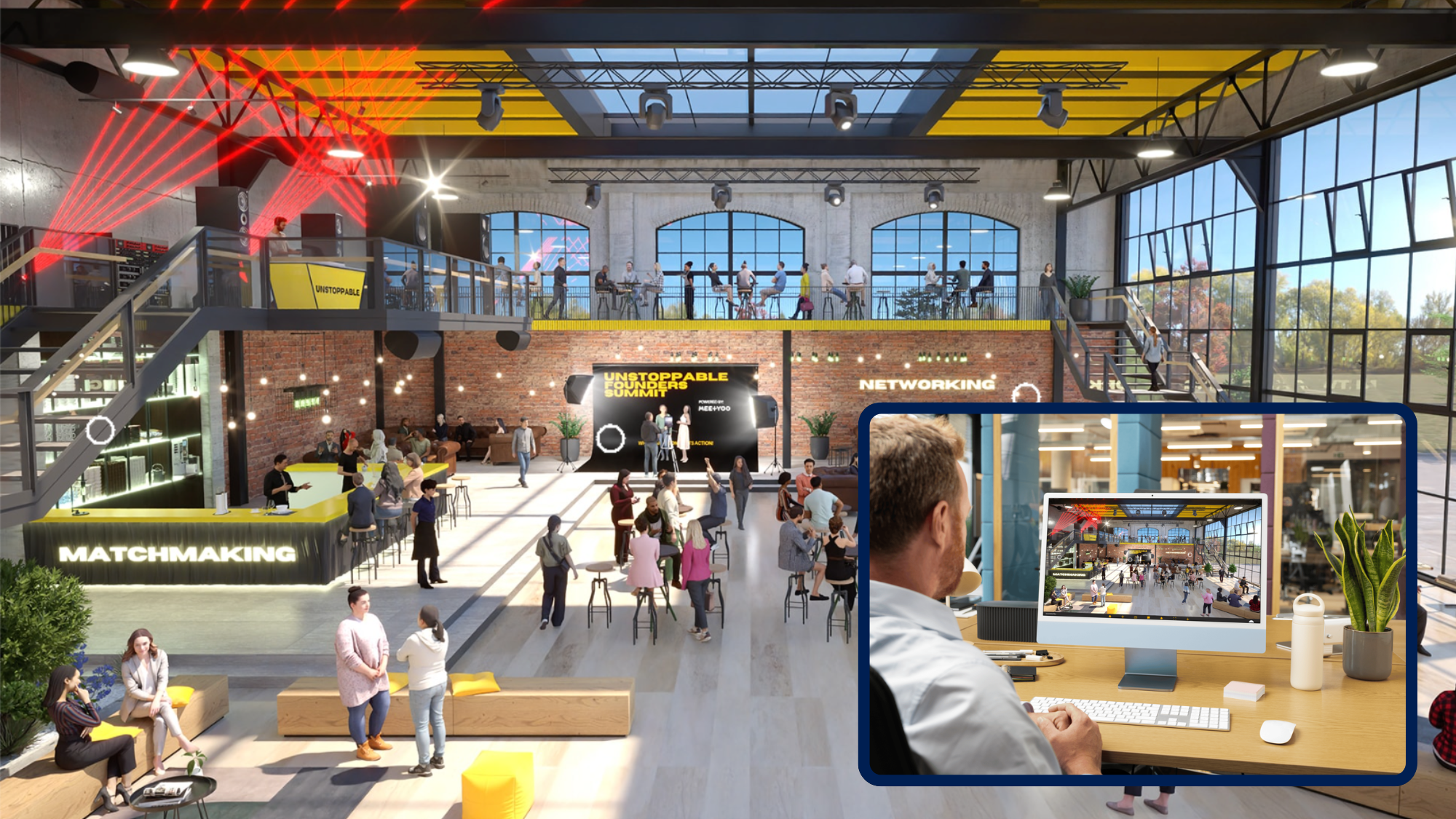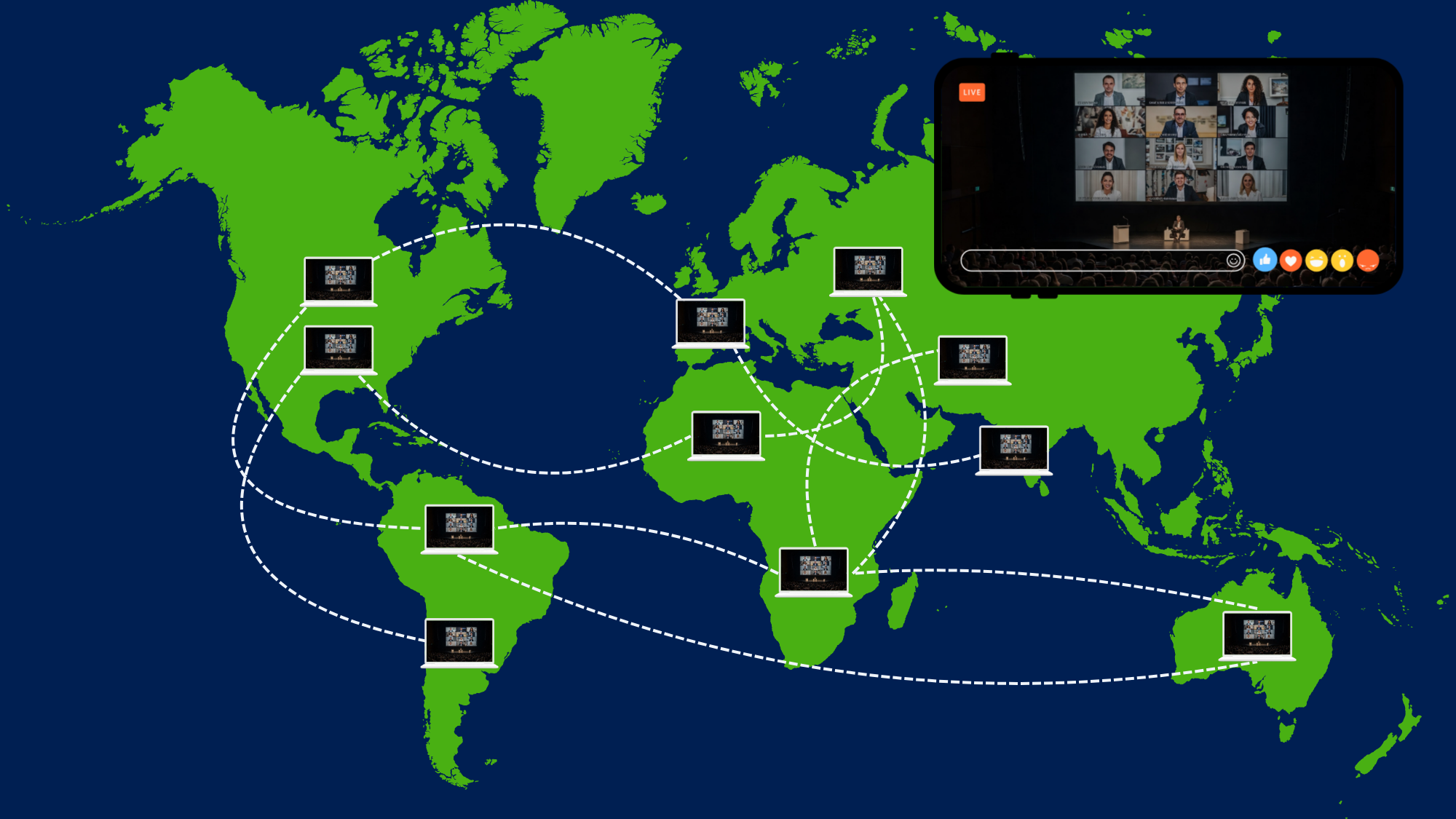Hybrid events are here to stay. But just because they offer flexibility and reach, that doesn’t mean they automatically deliver value. Many organisers still struggle to get a clear picture of success, especially when audiences are split across physical and virtual spaces. In this blog, we look at what makes hybrid events truly pay off - and what tends to fall short. We’ll break down how to measure ROI in a meaningful way, what challenges to watch out for, and how to build hybrid experiences that work for everyone involved. Because if we want to make the most of hybrid, we need to move beyond simply running two events at once - and start thinking about how to make one integrated experience that delivers results.
What ROI Means for Hybrid Events
ROI isn’t just about revenue, it’s about value. And that value looks different depending on the goals behind your event. For some, it’s lead generation. For others, it’s visibility, brand lift, or community building. The key is knowing what success should look like before the event even begins.
For hybrid events, that means setting clear, measurable objectives for both the in-person and online experience. Without that, it’s easy to focus too much on vanity metrics - like registration numbers - and miss the bigger picture.
Here are some of the indicators that matter when assessing ROI in a hybrid format:
- Attendance: How many people showed up, both in person and online? And more importantly, how many stayed?
- Engagement: Did people take part in polls, Q&A, networking, or downloads? Active participation is a stronger signal than passive viewing.
- Lead quality: Are the contacts captured during the event relevant and ready for follow-up?
- Content reach: How far did your content go? On-demand views and social shares add to the return, even after the event ends.
- Operational efficiency: Did the hybrid format help reduce travel, time, or budget compared to fully onsite events?
Tracking these metrics helps us understand whether the event delivered on its promise not just to us as organisers, but to attendees, sponsors, and partners too.
The Unique Challenge of Hybrid: Two Audiences, One Experience
Hybrid events come with a built-in tension: we’re designing for two audiences at the same time, and they’re having two very different experiences. One group is on-site, soaking in the atmosphere and face-to-face interactions. The other is remote, navigating the event from a screen.
When the experience isn’t balanced, it shows. Virtual attendees might feel like afterthoughts. In-person participants might find the content too tailored for online viewers. And sponsors often struggle to connect meaningfully with either group if the setup isn’t fully thought through.
The biggest mistake we see? Trying to run a physical event and just stream it online. That’s not hybrid - it’s a compromise. And it leads to lower engagement, uneven feedback, and unclear results.
A true hybrid event treats both audiences as equals. That means making space for participation across both formats, tailoring content where needed, and syncing the onsite and virtual elements so they feel like parts of a whole - not two different events running in parallel.
The goal isn’t to give everyone the same experience. It’s to give each audience the best possible version of the experience that works for them.

What Doesn’t Work
Not all hybrid setups are created equal. Some fall short because they miss the core principle: hybrid events need purpose-built design. When organisers treat the virtual element as an afterthought, the cracks show - and the ROI suffers.
Here are a few approaches that tend to underdeliver:
- Streaming without engagement: Simply broadcasting a live stage to remote viewers isn’t enough. It leaves virtual attendees watching, not participating. No polls, no interaction, no feedback - just passive viewing.
- Last-minute hybrid add-ons: Converting a physical event into a hybrid one a week before showtime rarely leads to a strong digital experience. The planning needs to start early and include both formats from the beginning.
- Focusing only on surface metrics: Registrations, page views, or login counts might look good in a report, but they don’t reflect real engagement or value. If people drop off early or don’t interact, it’s not a win.
These missteps don’t just affect the experience - they impact how well the event performs. And they make it harder to prove value to stakeholders, sponsors, or your own team.
What works
Hybrid events are most successful when they’re designed with intention. They aren’t an afterthought; they’re part of the strategy from the start. When carefully planned, hybrid formats can significantly enhance the event experience for both in-person and virtual attendees. Here’s what makes hybrid events truly shine:
- Plan for Two Audiences: A hybrid event requires balancing the needs of both in-person and virtual audiences. This means creating a seamless experience that engages both groups equally. It’s essential to build a hybrid event from the ground up - integrating technology and content in a way that ensures both groups feel like they are part of the same event. Whether it’s offering virtual Q&A sessions, live polls, or networking opportunities, engaging both audiences is key (read more).
- Build a Strong Attendee Base: Creating an engaged and committed audience starts well before the event. Consistently offering valuable content, such as blogs, videos, and behind-the-scenes glimpses, can build anticipation and excitement. Consider sharing highlights from past events or short clips to draw in potential attendees. Engaging with your audience on social media and through partnerships also helps expand your reach and solidify your event’s credibility.
- Invest in High-Quality Content: One of the benefits of hybrid events is the ability to redirect savings from smaller venue costs into enhancing content. Attendees - both virtual and in-person - come to learn and network. Offering well-researched presentations, top-tier speakers, and interactive sessions can significantly boost the value of your event. Strong content builds your brand’s credibility and encourages future attendance.
- Leverage Virtual Sponsorships: Hybrid events offer new sponsorship opportunities. Virtual sponsorships go beyond traditional banners and booths. Think about creating tiered sponsorship packages that cater to different budget levels and offer virtual engagement options like interactive sessions or sponsored networking breaks. These sponsorships not only generate revenue but also deepen the level of interaction for sponsors and attendees alike.

- Tailor the Content Experience: Not all content should be delivered in the same way to both groups. Virtual sessions can be shorter, more focused, and interactive, while in-person sessions might involve more traditional formats. Providing distinct experiences for each audience ensures both groups get the most out of the event. It also opens the door for more exclusive online content, such as virtual-only workshops or roundtable discussions.
- Foster Networking and Community: One of the greatest benefits of hybrid events is the ability to connect attendees from all over the world. To maximize engagement, ensure that virtual and in-person attendees have ample networking opportunities. Virtual lounges, breakout sessions, and networking rooms can help facilitate organic interactions. Gamification elements, such as virtual scavenger hunts or trivia games, can keep both virtual and live audiences engaged and excited.
- Maximize ROI with Strategic Planning: While ROI is often measured in revenue, it’s also reflected in brand awareness, lead generation, and community growth. By focusing on delivering value through quality content, engaging interactions, and thoughtful planning, you can create an event that boosts your brand and strengthens relationships with your audience. Additionally, using data analytics and exploring new revenue streams like sponsorships or tiered ticketing can further enhance the event’s ROI.
- Create Long-Term Value: A successful hybrid event doesn’t just end when the final session wraps up. It should leave a lasting impact by fostering community, building connections, and offering valuable follow-up content. On-demand access to keynotes, workshops, and networking opportunities can extend the life of your event and continue to engage your audience long after the event has finished. This ongoing interaction helps solidify your event’s role as an important resource for your community. To support this long-term value, we offer a dedicated Content Hub. It’s designed to manage and deliver your event content efficiently - long after the live sessions are over. Whether it’s keynotes, breakout recordings, PDFs, or interactive tools, our Content Hub provides your audience with easy access to everything in one central location. It’s ideal not just for events, but also for onboarding, e-learning, and internal communications.
Measuring ROI - Tools and Techniques
To understand if a hybrid event delivered value, we need to measure what matters. That means going beyond basic numbers and digging into performance across both formats. It also means having the right tools in place before the event starts. Here’s how to approach it:
- Set clear objectives early: ROI starts with intention. Are you trying to generate leads? Educate an audience? Build brand loyalty? Whatever your goal, define it in measurable terms. That way, you know what success looks like and what to track.
- Track engagement, not just attendance: Logins don’t mean much if people don’t participate. Look at session duration, interaction rates, content downloads, and chat activity. These give a better sense of whether the content resonated.
- Collect feedback while it’s fresh: Surveys after sessions - or at the close of the event - help capture real-time reactions. Keep it short and focused. Ask about content quality, technical experience, and overall satisfaction. And include both audiences.
- Measure follow-up outcomes: ROI doesn’t end when the event does. Track how many leads convert, how content is reused, and how your audience grows after the event. A well-run hybrid format should leave a longer tail of value. The goal isn’t just to report results - it’s to learn from them. With the right tools and mindset, each event can improve on the last.

Closing Thoughts - Making Hybrid Events Worth It
Hybrid events offer reach, flexibility, and long-term value when they’re planned with care. It’s not enough to run a live event and livestream it. To truly deliver ROI, we need to think differently.
That means starting with clear goals, designing for both audiences from day one, and measuring what really counts. It also means using platforms and tools that make engagement easy and insights visible.
The best hybrid events feel seamless, whether you’re in the room or joining remotely. They create a sense of inclusion and connection that goes beyond the format. And when they work, the return speaks for itself - in stronger engagement, better outcomes, and more impact over time.





